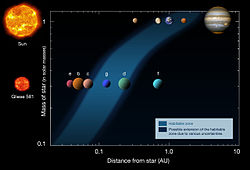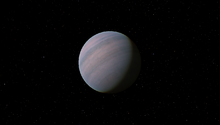Gliese 581d: Difference between revisions
No edit summary |
m Reverted edits by 2601:B:9E80:3EC:C9C0:E570:3D22:D8D0 (talk) to last version by RS-No-How |
||
| Line 1: | Line 1: | ||
{{Planetbox begin |
{{Planetbox begin |
||
| name = Gliese 581 d |
| name = Gliese 581 d |
||
}} |
|||
temperature=181 |
|||
{{Planetbox star |
{{Planetbox star |
||
| star = [[Gliese 581]] |
| star = [[Gliese 581]] |
||
Revision as of 21:44, 28 November 2013
Template:Planetbox begin Template:Planetbox star Template:Planetbox orbit Template:Planetbox character Template:Planetbox discovery Template:Planetbox catalog Template:Planetbox reference Template:Planetbox end
Gliese 581 d /ˈɡliːzə/ or Gl 581 d is a proposed extrasolar planet orbiting the star Gliese 581 approximately 20 light-years away in the constellation of Libra. It was the third planet claimed in the system and (assuming a six-planet model) the fifth in order from the star.
Though not confirmed to be a terrestrial planet and significantly more massive than Earth (at 3.1 Earth masses), the Super-Earth is the first exoplanet of terrestrial mass proposed to orbit within the habitable zone of its parent star.[1]
Assuming its existence, computer climate simulations have confirmed the possibility of the existence of surface water and these factors combine to a relatively high measure of planetary habitability. It would have an Earth Similarity Index of 0.74.
Proposed discovery
A team of astronomers led by Stéphane Udry of the Geneva Observatory used the HARPS instrument on the European Southern Observatory 3.6 meter telescope in La Silla, Chile to discover the planet in 2007. Udry's team employed the radial velocity technique, in which the mass of a planet is determined based on the small perturbations it induces in its parent star’s orbit via gravity.[2]
In September 2012, Roman Baluev filtered out the "red noise" from the Keck data and concluded that this planet's existence is probable only to 2.2 standard deviations.[3]
Orbital characteristics
Gliese 581 d orbits Gliese 581 at 0.21847 AU, approximately a fifth of the distance that the Earth orbits the Sun, though its orbital eccentricity has not been confirmed. There are currently two models for its orbit, a circular one like Earth's, and an eccentric one like Mercury's. These are based on the four planet and six planet model for the Gliese 581 system, respectively. Under the four planet model Gliese 581 d would most probably be in a spin-orbit resonance of 2:1, rotating twice for each orbit of its parent star. Therefore the day on Gliese 581 d should approximately be 67 Earth’s days long.[4][5]
The orbital distance places it at the outer limits of the habitable zone, the distance at which it is believed possible for water to exist on the surface of a planetary body. At the time of its discovery, the planet's orbit was originally believed to be farther out, however in late April 2009 the original discovery team revised its original estimate of the planet's orbital parameters, finding that it orbits closer to its star than originally believed with an orbital period of 66.87 days. They concluded that the planet is within the habitable zone where liquid water could exist.[6][7] However, data [8] also suggests that the proposed exoplanet [9]could have at least one[10] or more large oceans.
Physical characteristics
The motion of the parent star indicates a minimum mass for Gliese 581 d of 5.6 Earth masses (earlier analyses gave higher values).[11] Dynamical simulations of the Gliese 581 system assuming that the orbits of the three planets are coplanar show that the system becomes unstable if the masses of the planets exceed 1.6 – 2 times the minimum values. Using earlier minimum mass values for Gliese 581 d, this implies an upper mass limit for Gliese 581 d of 13.8 Earth masses.[6] The composition of the planet, however, is not known.
Climate and habitability

As the planet is not known to transit from Earth and atmospheric conditions are not observable with current technology, no atmosphere for the planet has been confirmed to date. As such, all climate predictions for the planet are based on predicted orbits, computer modelling of theoretical atmospheric conditions.
Because Gliese 581 d was believed to orbit outside the habitable zone of its star it was originally thought to be too cold for liquid water to be present. With the 2009 revised orbit, climate simulations conducted by researchers in France in 2011 indicated possible temperatures suitable for surface water at sufficient atmospheric pressure[1] According to Stéphane Udry, "It could be covered by a 'large and deep ocean'; it is the first serious ocean planet candidate."[12]
On average, the light that Gliese 581 d receives from its star has about 30% of the intensity of light the Earth receives from the Sun. By comparison, sunlight on Mars has about 40% of the intensity of that on Earth. That might seem to suggest that Gliese 581 d is too cold to support liquid water and hence is inhospitable to life. However, an atmospheric greenhouse effect can significantly raise planetary temperatures. For example, Earth's own mean temperature would be about −18°C[13] without any greenhouse gases, ranging from around 100°C on the day side to −150°C at night, much like that found on the Moon. If the atmosphere of Gliese 581 d produces a sufficiently large greenhouse effect, and the planet's geophysics stabilize the CO2 levels (as Earth's does via plate tectonics), then the surface temperature might permit a liquid water cycle, conceivably allowing the planet to support life.[14][15][16][17] Calculations by Barnes et al. suggest, however, that tidal heating is too low to keep plate tectonics active on the planet, unless radiogenic heating is somewhat higher than expected.[18]
Gliese 581 d is probably too massive to be made only of rocky material. It may have originally formed on a more distant orbit as an icy planet that then migrated closer to its star.[19][20]
Messages from Earth

In October 2008, members of the networking website Bebo beamed A Message From Earth, a high-power transmission at Gliese 581, using the RT-70 radio telescope belonging to the National Space Agency of Ukraine. This transmission is due to arrive in the Gliese 581 system's vicinity by the year 2029; the earliest possible arrival for a response, should there be one, would be in 2049.[21]
As part of the 2009 National Science Week celebrations in Australia, Cosmos Magazine launched a website called Hello From Earth to collect messages for transmission to Gliese 581d. The maximum length of the messages was 160 characters, and they were restricted to the English language. In total, 25,880 messages were collected from 195 countries around the world. The messages were transmitted from the DSS-43 70 m radio telescope at the Canberra Deep Space Communication Complex at Tidbinbilla, Australia on the 28th of August, 2009.[22]
See also
- Earth analog
- Gliese 581 g
- Gliese 667 Cc
- Habitable zone
- HD 85512 b
- Kepler 22 b
- List of potential habitable exoplanets
- Planetary habitability
- Super-Earth
References
- ^ a b Wordsworth, R. (2011). "Gliese 581d is the first discovered terrestrial-mass exoplanet in the habitable zone". arXiv:1105.1031 [astro-ph.EP].
{{cite arXiv}}: Unknown parameter|coauthors=ignored (|author=suggested) (help) - ^ "The HARPS search for southern extra-solar planets", S. Udry. X. Bonfils. X. Delfosse. T. Forveille. M. Mayor. C. Perrier. F. Bouchy. C. Lovis. F. Pepe. D. Queloz. J.-L. Bertaux. The Extrasolar Planets Encyclopaedia. April 4, 2007. Accessed June 10, 2011
- ^ Roman Baluev (2012). "The impact of red noise in radial velocity planet searches: Only three planets orbiting GJ581?". arXiv:1209.3154. Bibcode:2013MNRAS.429.2052B. doi:10.1093/mnras/sts476.
{{cite journal}}: Cite journal requires|journal=(help) - ^ Makarov, Valeri V.; et al. (2012). "Dynamical evolution and spin-orbit resonances of potentially habitable exoplanets. The case of GJ 581d". The Astrophysical Journal. 761. arXiv:1208.0814. Bibcode:2012arXiv1208.0814M. doi:10.1088/0004-637X/761/2/83.
- ^ Heller, René; Barnes, Rory; Leconte, Jérémy. (2011). "Habitability of extrasolar planets and tidal spin evolution". Origins of Life and Evolution of Biospheres. Onlinefirst. arXiv:1108.4347. Bibcode:2011OLEB..tmp...37H. doi:10.1007/s11084-011-9252-3.
{{cite journal}}:|access-date=requires|url=(help); Unknown parameter|month=ignored (help)CS1 maint: bibcode (link) - ^ a b M. Mayor, X. Bonfils, T. Forveille, X. Delfosse, S. Udry, J.-L. Bertaux, H. Beust, F. Bouchy, C. Lovis, F. Pepe, C. Perrier, D. Queloz, N. C. Santos (2009). "The HARPS search for southern extra-solar planets,XVIII. An Earth-mass planet in the GJ 581 planetary system". arXiv:0906.2780 [astro-ph].
{{cite arXiv}}: CS1 maint: multiple names: authors list (link) - ^ "Lightest exoplanet yet discovered". eso.org. 2009-04-21. Retrieved 2009-04-21.
- ^ R. Stewart, (2013). " First View of Gliese-581 d; A preliminary Surface Survey (Part-1). Publisher-(IJAAR), (Issue 2013). At-http://www.journals-of-science.com/5-feature-research-pap.html
- ^ STEWART, R., CELEBONOVIC, V., AGUIAR, O.A.,CHATZITHEODORIDIS, E., ACKERMAN, J., ROMAN, M.,ARTUSO, G., TRENTADUE, W., SAMADI, A., ARISTIZABAL,C.I.O. and others. Gliese 581d; Views of Its atmospheric, topographical, geological, and oceanic conditions (Part 2). Journal of The International Society of Peer Reviewers. Available at: http://www.stewart-research-consulting.com/8-astronomy.html . Which in summary shows its atmosphere geology topography and oceanic conditions.
- ^ AGUIAR, O.A., STEWART, R., ARTUSO, G., SAMADI, A., ARISTIZABAL, C.I.O., ACKERMAN, J.R., TRENTADUE, W. The (possible)conrmation of the First exo-oceans. Pluralidade 1: 82-95, 2013. At- http://www.pluralidade.info/Eindex.html .
- ^ Cite error: The named reference
Vogtwas invoked but never defined (see the help page). - ^ "Lightest exoplanet yet discovered", European Southern Observatory. April 21, 2009. Accessed June 10, 2011
- ^ "Global Warming Frequently Asked Questions". Lwf.ncdc.noaa.gov. 2008-05-08. Retrieved 2009-01-18.
- ^ von Bloh, W.; et al. (2008). "Habitability of Super-Earths: Gliese 581c and 581d". Proceedings of the International Astronomical Union. 3. arXiv:0712.3219. doi:10.1017/S1743921308017031.
- ^ "Centauri Dreams » Blog Archive » Gliese 581d: A Habitable World After All?". Centauri-dreams.org. 2007-12-13. Retrieved 2009-01-18.
- ^ Posted at 12:06 AM in Space Exploration (2007-06-15). "New 'Super Earth 2' Discovered in Constellation Libra". Dailygalaxy.com. Retrieved 2009-01-18.
{{cite web}}: CS1 maint: numeric names: authors list (link) - ^ Wordsworth, Robin; François Forget; Franck Selsis; Ehouarn Millour; Benjamin Charnay; Jean-Baptiste Madeleine (1970). "Gliese 581d is the first discovered terrestrial-mass exoplanet in the habitable zone". arXiv:1105.1031 [astro-ph.EP].
{{cite arXiv}}: Unknown parameter|work=ignored (help) - ^ Barnes, Rory; Jackson, Brian; Greenberg, Richard; Raymond, Sean N. (2009-06-09). "Tidal Limits to Planetary Habitability". The Astrophysical Journal. 700: L30–L33. arXiv:0906.1785. Bibcode:2009ApJ...700L..30B. doi:10.1088/0004-637X/700/1/L30.
- ^ SPACE.com - Hopes Dashed for Life on Distant Planet
- ^ von Bloh, W.; Bounama, C.; Cuntz, M.; Franck, S. (2007). "The Habitability of Super-Earths in Gliese 581". Astronomy & Astrophysics. 476 (3): 1365–1371. arXiv:0705.3758. Bibcode:2007A&A...476.1365V. doi:10.1051/0004-6361:20077939.
{{cite journal}}: CS1 maint: multiple names: authors list (link) - ^ "Zimbio Pilot - Gliese 581c". Zimbio.com. 2008-10-13. Retrieved 2009-04-23.
- ^ Jenkins, Simon (2009-08-28). "Earth sends 25,000 hellos to outer space". Brisbane Times. Retrieved 2009-09-16.
External links
- National Science Week 2009 - Send A Message To Gliese 581d
- Wordsworth, R. D.; et al. (2010). "Is Gliese 581d habitable? Some constraints from radiative-convective climate modeling". Astronomy & Astrophysics. 522: A22. arXiv:1005.5098. Bibcode:2010A&A...522A..22W. doi:10.1051/0004-6361/201015053.

